The Ramayana is one of the two most important ancient epics of India and Hindu religion, the other being the Mahabharata. It is a Sanskrit epic poem that tells the story of the life and adventures of prince Rama, the seventh incarnation of Vishnu.
Attributed to the sage Valmiki, it is believed to have been composed between 400 BCE and 200 BCE. The word Ramayana derives from Rama, the Hindu hero of the story, and Yana, meaning journey.
The Ramayana has been a major influence on the culture and values of India for thousands of years. It has been adapted into various forms of art, including dance, music, and theater, and has been the subject of numerous scholarly interpretations and commentaries.
Featured Image:Tropenmuseum, part of the National Museum of World Cultures, COLLECTIE TROPENMUSEUM Bas-reliëf op de Candi Lara Jonggrang oftewel het Prambanan tempelcomplex TMnr 10028338, CC BY-SA 3.0
You may also like:
Lord Rama: One of the Most Beloved Hindu Gods
Ram Navami: One of the Most Important Hindu Celebrations
Rama Navami Symbolism: The Triumph of Good Over Evil
Table of Contents
- The Story of the Ramayana in a Nutshell
- The Structure of the Ramayana
- The Main Story of the Ramayana
- Birth & Early Years of Rama
- Rama’s Marriage to Sita
- The Exile to the Forest
- The Encounter with Surpanakha
- The Abduction of Sita by Ravana
- The Quest for Sita
- The Battle with Ravana
- Sita’s trial by fire
- The Return of Rama to Ayodhya
- Hanuman’s Devotion
- Rama exiles Sita to the Forest
- The Ascent to heaven
- Versions of the Ramayana Story
The Story of the Ramayana in a Nutshell
The main story of the Ramayana revolves around Rama’s quest to rescue his wife Sita, who has been abducted by the ten-headed demon king Ravana. With the help of his brother Lakshmana and the monkey warrior Hanuman, Rama embarks on a journey across India to find and defeat Ravana, and rescue Sita. Along the way, Rama is aided by an army of monkeys led by Hanuman, a devoted follower of Rama.
After an intense battle, Rama kills Ravana and rescues Sita. To prove that she is loyal to Rama, Sita takes the test of fire (Agni Pariksha) and escapes the flames unscathed. Together with Lakshman, Hanuman and Sita, Rama returns to Ayodhya, where he is crowned king. However, due to peoples’ rumors and gossips about Sita’s loyalty, after being held captive at Ravana’s palace, Rama decided to exile her to the forest. Sita, who was pregnant at the time, finds refuge at sage Valmiki’s hermitage, where she eventually gave birth to twin sons.
After twelve years in exile, Sita returned to Ayodhya only to have her loyalty challenged yet again. This time, Sita invokes Mother Earth to take her home as proof of her faithfulness to Rama. The earth shook, opened up and swallowed Sita. From that moment Rama realized that he would never see Sita again. He continued to rule the kingdom for many years until one day he drowns himself, only to join Sita in afterlife.
The Structure of the Ramayana
The Ramayana epic consists of some 24,000 verses, divided into seven books (kandas). Namely, Balakanda, Ayodhyakanda, Aranyakanda, Kiskindakanda, Sundarakanda, Yuddhakanda and Uttarakanda.
The Bala kanda, introduces Ramayana’s main characters and describes Rama’s birth, childhood, and marriage to Sita. It also introduces the villainous character Ravana, who becomes the main antagonist of the story.
The Ayodhya Kanda, starts with Dasaratha’s desire to crown Rama heir to the throne and the treacherous plot of Kaykeki that led to Rama’s exile. It also describes how Rama left Ayodhya and his journey to the forest with his wife Sita and brother Lakshmana.
The Aranya Kanda, narrates the chronicle of the years in exile and the events leading to Sita’s abduction by Ravana.
The Kiskinda Kanda, tells how Rama and his brother Lakshman meet Hanuman, and how they help Sugriva, the monkey king, regain his kingdom from his evil brother Vali.
The Sundara Kanda, provides an account of Hanuman’s heroics and how he manages to reach Lanka and find out the place where Sita is held captive.
The Yuddha Kanda, provides the details of the battle and the victory over Ravana. It also describes Sita’s pyre trial and how Agni, the god of fire, carries Sita in his arms and restores her to Rama. The Yuddhakanda ends with a description of Rama’s coronation as king of Ayodhya.
The Uttara Kanda, narrates Rama’s reign, the banishment of Sita to the forest and her reunion with Rama. The Kanda ends with the last days of Rama and his eventual ascent to heaven to meet Sita. The Uttara Kanda is a later addition to the Ramayana and is not considered part of the original Valmiki text by many scholars.
The Main Story of the Ramayana
In order to provide you with an accurate synopsis of this great epic, we have summarized it in concise, easy to follow sections:
Birth & Early Years of Rama
Lord Rama was born to King Dasaratha and Queen Kaushalya of Ayodhya. The old king had three wives: Kaikeya, Sumitra, and Kushalya, but none could bear him an heir. In order to be blessed with children, the sage Vasashtha suggested performing a sacred rite called Putrakameshthi Yagna. After performing the yagna, the king was blessed with four sons, Rama being the eldest.
As a child, Rama, the crown prince of Ayodhya, showed signs of great wisdom, strength, and courage. He received a rigorous education in various fields, including archery, warfare, and governance. His skills in these areas would later prove invaluable in his battles against demons and in his rule as a king.
Rama’s Marriage to Sita
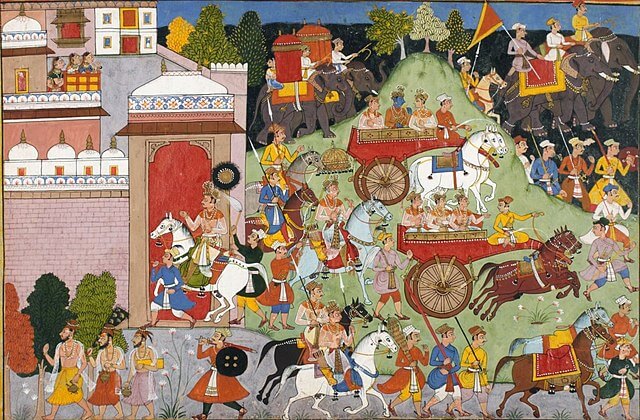
The marriage of Sita and Rama is considered one of the most important love stories of all time. Sita was the daughter of King Janaka, the ruler of Mithila, and was known for her beauty, wisdom, and virtue. To determine who would be worthy of marrying Sita, King Janaka decided to hold a competition. The winner would have to lift and string a mighty bow that once belonged to god Shiva, and no one had been able to lift before.
Many princes and warriors tried to lift the bow, but all of them failed. When Lord Rama arrived at the competition with his younger brother Lakshmana, he easily lifted the bow, strung it, and then broke it in half. The assembled crowd was amazed, and King Janaka declared that Lord Rama was the winner and that Sita would marry him.
The Exile to the Forest
Kaikeyi, the second wife of King Dasharatha, wanted to promote her son, Bharata, as the heir to the throne instead of Prince Rama. She schemed a plot and managed to banish Rama from the palace of Ayodhya. Rama, along with his wife Sita and younger brother Lakshmana, was forced to exile.
During their fourteen years long exile, Rama and his companions faced many challenges, including battles against powerful demons and struggles with hunger, thirst, and exhaustion.
The Encounter with Surpanakha
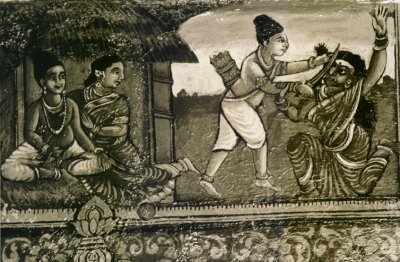
One day, while in the forest, Rama, Sita and Lakshmana encountered the demoness Surpanakha, who was the sister of the demon Ravana, the ten-headed king of Lanka.
When Surpanakha saw Rama she fell in love with him and tried to seduce him. However, Rama would never betray Sita and rejected Surpanakha’s advances. Enraged for failing to seduce Rama, Surpanakha tried to attack Sita, however, Laksmana reacted fast and cut off her nose and ears in the process.
Surpanakha then sought the help of her demon brothers Khara and Dushana who lived nearby. She explained what happened and they decided to take revenge. They gathered an army of demons and attacked Rama and Lakshamana. The battle was hard but in the end the demons and 14,000 of their army were killed.
After seeing that, Surpanakha fled to her demon brother Ravana, and told him about the events and Rama’s wife. Ravana decided to avenge by abducting the wife of Rama.
The Abduction of Sita by Ravana
The golden deer
Ravana was attracted to Sita’s beauty and plotted to abduct her. He went to his demon uncle, Mareecha, who had the power to transform himself into any form and even change his voice accordingly. Mareecha agreed to help and disguised himself as a golden deer to lure Rama away from Sita.
The deer was so beautiful that Sita begged Rama to catch it for her. As Rama chased the golden deer, it led him deeper and deeper into the forest, far away from Sita and Lakshmana. Managing to catch up, Rama moved closed and shot an arrow, killing the golden deer.
However, when the arrow stuck the deer, it transformed itself back into Mareecha. Using his powers, he cried out to Laxmana for help in Rama’s voice and then died. When Sita heard Rama’s voice calling out for help she feared that he was in danger. She urged Lakshmana to go in search of Rama, but he had been given strict instructions to stay with Sita at all times and protect her.
But, as Sita became increasingly worried, Lakshmana finally decided to rush to Rama’s aid. Before leaving, he drew a protective circle around Sita and instructed her not to step outside of it under any circumstances.
Ravana, who had been watching the events unfold, took advantage of Lakshmana’s absence and appeared before Sita disguised as a beggar. He convinced her to step outside the protective circle and abducted her, taking her on his chariot and heading south to his palace in Lanka.
Jatayu Tries to Save Sita
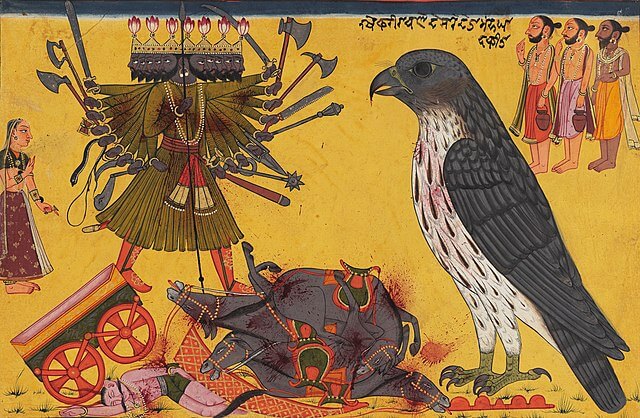
Jatayu, the vulture king who had always protected Sita when Rama and Lakshama went out hunting, attacked Ravana and tried to stop him. However, Ravana managed to kill Jatayu by cutting off both of his wings.
Once in Lanka, Ravana tried to persuade Sita to marry him, however, she remained loyal to Rama and declined his proposal. Meanwhile, Rama and Lakshmana discovered that Sita was missing and were informed of her abduction by the dying Jatayu. Without delay, they embarked on a mission to locate her. Along the way, they encountered the demon Kabandha and the ascetic woman Shabari, who guided them towards Sugriva and Hanuman.
The Quest for Sita
Based on the guidance from Kabandha and Shabari, Rama and Lakshmana proceeded into Kiskindha, which was the realm of the monkeys. The gateway was protected by Hanuman, who was a loyal follower of Sugriva, the monkey king.
Hanuman asked Rama who they were and after Rama said their names, he escorted them before the deposed king Sugriva. Rama and Lakshman agreed to help him regain his kingdom on condition that he would help them find Sita. Rama and Lakshman managed to defeat Vali, Sugriva’s evil brother, and won the throne back for him. In return, Sugriva let Hanuman and his army of monkeys join Rama and his brother in their quest.
Hanuman split the monkey army into four teams and sent them on all four directions searching for Sita. On his search Hanuman met the brother of Jatayu who informed him that Sita was kept captive in Lanka. By using his magical powers, Hanuman crossed the ocean and managed to find Sita in a grove full of trees. When Hanuman introduced himself as a messenger of Rama, Sita asked him to go back to Rama and tell him to come rescue her. Hanuman flew back to Rama to bring him the good news, but not before causing havoc in the demon city of Lanka.
The Battle with Ravana
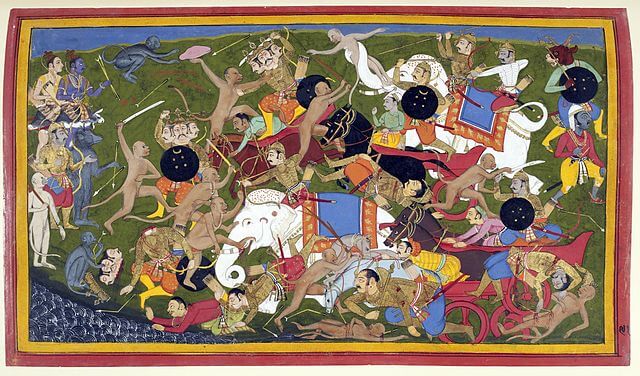
With the help of Sugriva, Rama gathered an army of monkeys and together with Lakshmana and Hanuman, they crossed the ocean to reach Lanka and mount a rescue mission.
The battle with Ravana was intense and lasted for several days. Lord Rama and his army faced many perils and dangers. They fought bravely in order to overcome Ravana’s magical abilities, as well as his powerful army. In the end, they managed to defeat their powerful opponents. Ravana was slain and Sita was rescued.
Sita’s trial by fire
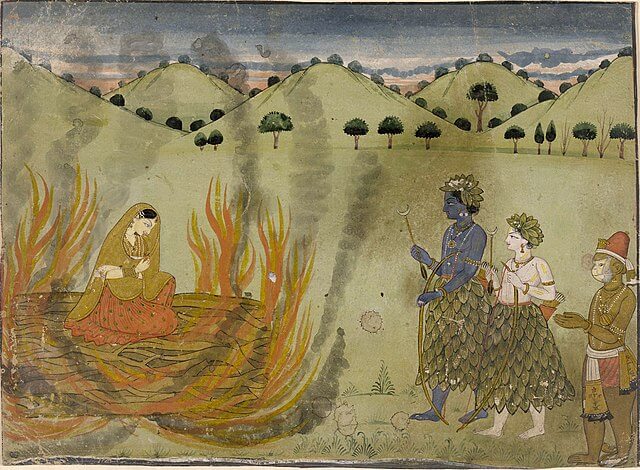
When Sita is brought before Rama he asked her to prove her chastity, so that no doubt would be cast. Determined to prove her faithfulness to Rama, Sita undergoes the trial by fire or Agni Pariksha. The fire god Agni appears, takes Sita in his arms and restores her back to Rama. Rama embraces her and together with his army they return triumphantly to their kingdom of Ayodhya.
The Return of Rama to Ayodhya
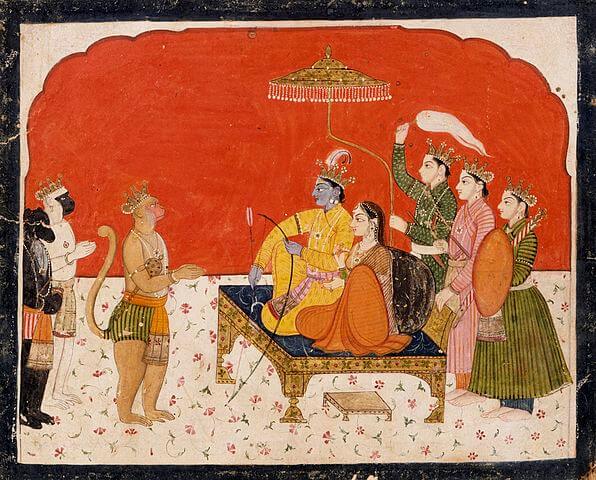
When Rama returns to Ayodhya, after fourteen years of exile, the people of the city welcomed him and his companion with great joy and celebration. The streets were decorated with flowers and little lamps (diyas) to light their way.
Even today, people celebrate the festival of lights – Diwali, where they place lights in their windows to welcome Sita/Lakshmi, the symbol of wealth and prosperity, into their homes.
After his triumphant return to Ayodhya, the hero Rama became king of Ayodhya and he ruled the kingdom with wisdom and justice. He was a wise and just ruler, and his reign, known as Ram Jaya, was marked by peace and prosperity.
Hanuman’s Devotion
After the battle with Ravana, Rama thanked and gave gifts to everyone who helped him, including Hanuman. However, Hanuman didn’t keep the gift and instead said that he would always remember Rama in his heart. This upset some court officials who asked Hanuman for proof. Without hesitation, Hanuman tore his chest open and showed them the image of Rama and Sita on his heart.
Rama exiles Sita to the Forest
After the coronation, Rama is informed of the peoples’ rumors and gossip about Sita’s chastity and gets frustrated since Sita had already proven her innocence. However, to uphold the law of dharma, King Rama asked Lakshmana to escort Sita to the forest, where she finds refuge at the hermitage of Valmiki. Sita, who was pregnant when Rama banished her, gave birth to twin sons, Kusa and Lava.
The Ascent to heaven
After twelve years in exile, Sita finally went back to Ayodhya. However, her loyalty is challenged yet again by Nagarasen, one of Rama’s ministers. This time, Sita invokes Mother Earth to take her home as proof of her faithfulness and devotion to Rama. The earth shook, opened up and swallowed Sita. From that moment, Rama realized that he will never see Sita again. He continued to rule the kingdom for many years until one day he drowns himself, only to join Sita in afterlife.
Versions of the Ramayana Story
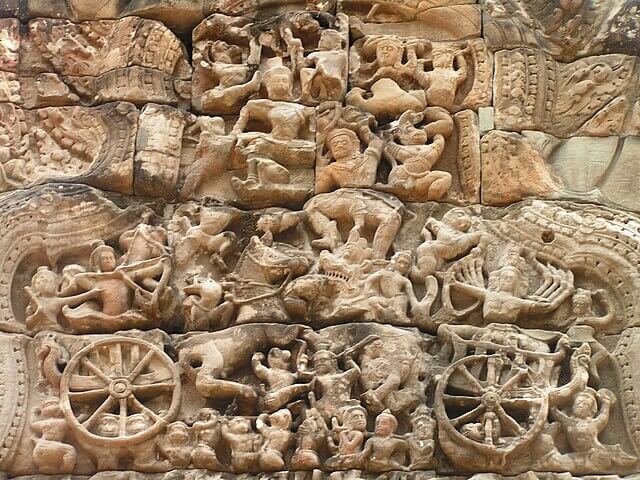
The ancient Indian epic of Ramayana was written by the sage Valmiki, however, other versions retell the story of Ramayana in a different way. There are many regional versions of the story of Rama, written by various authors in south and north India. Some of them differ significantly from each other.
Outside of India, Rama’s story also influenced the whole of south east Asia to a great extent. The Ramayana became an important part of the cultural and artistic heritage of countries such as Indonesia, Cambodia, Thailand, and Malaysia.
- Ardhanarishvara: The Powerful Synthesis of the Two Opposites in One

- Hanuman: The Most Valuable Life Lessons from the Monkey God

- King Kakudmi: One of the Most Amazing Hindu Myths

- Kakbhushundi: One of the Most Fascinating Tales from Hindu Mythology

- Ashtavakra Gita: One of the Greatest Masterpieces of Hindu Philosophy

- Mudgala Purana: Unveiling the Most Popular Ganesha Avatars






